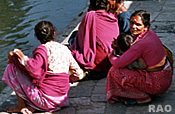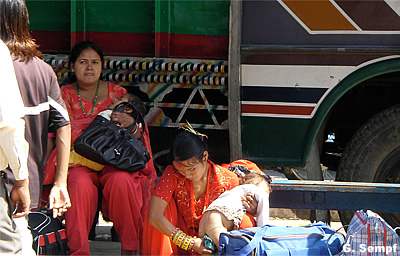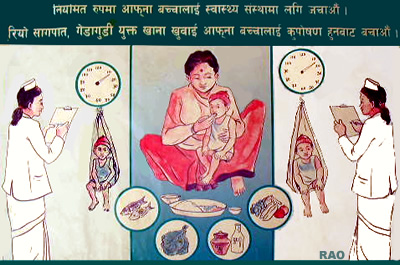 |
Nepal SOCIAL LIFE |
|
 |
Nepal Information |
|
|
 |
|
Reproductive
health and the conflict
|
 |
 |
| Most women are not as lucky as Shanta Karki
For
Shanta Karki, life simply could not get any better. Having already given
birth to three healthy girls, her lifelong dream of finally having a son
has come true. "I feel good. I'm happy.
And
I'm ready to go home," the 32-year-old said, beaming from her bed at the
Kathmandu Model Hospital, a private community-based hospital in the Nepalese
capital. "There were no problems and no complications so I guess I'm lucky."
But
luck is just part of the equation, say experts, making Shanta's case more
the exception than the rule. |
|
In
Nepal, many women continue to die during childbirth due to severe bleeding,
sepsis, toxaemia, obstructed labour and the consequences of abortion -
most of which could be prevented if essential obstetric care services were
available.
In
mountainous Nepal, however, a country crippled by the longstanding Maoist
insurgency to overthrow the state - a conflict which has already taken
the lives of more than 13,000 over the past decade - reproductive health
has long taken a backseat to what some in the donor community might see
as more pressing humanitarian needs, such as food, shelter, security and
the plight of children.
Those
issues not withstanding, the importance of reproductive health, particularly
given the conflict's impact, cannot be denied.
 |
| "Unfortunately,
in times of war, women's health, and more specifically, women's reproductive
health is overlooked," Junko Sazaki, Country Representative for the United
Nations Population Fund (UNFPA) in Nepal said in Kathmandu, emphasising
the catastrophic consequences it had had on women, children and the community
as a whole.
"Pregnancy
and childbirth is increasingly becoming a nightmare for many women due
to the disruption of health services," Sazaki explained, particularly in
rural areas of Nepal where the vast majority of the country's 28 million
inhabitants live. |
|
According
to the UN agency, reproductive health clinics have often been closed or
destroyed in many conflict-affected areas, while elsewhere shutdowns, curfews
and roadblocks imposed by both parties to the conflict have seriously disrupted
the supply of essential medicines.
Additionally,
fear and restricted freedom of movement have particularly affected pregnant
women, with innumerable reports of pregnant women dying in childbirth due
to reoccurring blockades or curfews.
Most
troubling of all, the fact remains that most women in Nepal give birth
at home, with only one in eight attended by a doctor or midwife, UNFPA
claims.
 |
| And
with women in Nepal having more than four children on average, that's a
disaster in the making.
"Only
18 percent of all deliveries nationwide are attended by skilled birth attendants,"
Sazaki said, describing the country's maternal mortality rate of 539 per
100,000 live births as one of the worst in Asia.
"That's
quite high and sadly, that's preventable. "They [qualified health experts]
can recognise a high-risk birth when they see it and can make the proper
referral," she said.
Yet
with up to 80 percent of the country under Maoist control, according to
some, such referrals are often all but impossible. Fearful of harassment
from both sides of the conflict, health workers increasingly prefer to
stay in the cities out of fear for their own personal security.
"It's
dangerous - plain and simple," one health worker, who declined to be identified,
maintained matter-of-factly. |
|
Meanwhile,
where health clinics have opened, frequent disruptions - including visits
by combatants from both sides - challenge service providers and intimidate
users, according to the UN.
Women
with routine problems often face years of problems as a consequence - and
conditions such as a prolapsed uterus, common in developing countries -
particularly amongst younger women - reach epidemic proportions in rural
areas.
According
to UNFPA, 50 percent of women under the age of 20 are already married in
Nepal, with one-fourth of them already mothers or pregnant.
"They
start their reproductive life earlier which means they deliver when their
bodies are not yet ready," Sazaki explained.
Often
attributed to lifting heavy objects or bearing many children, according
to a report entitled 'The Neglected Case of the Fallen Womb', published
in the Himal South Asian press, a prolapsed uterus describes a condition
in which the uterus, a curved sack expanding at the top and narrowing towards
the bottom, comes out through the vaginal opening, causing the utmost discomfort
if not treated.
"They
don't know what it is and consequently don't get the healthcare they need
to rectify the problem," Sazaki said. "It's really something that can be
treated immediately."
But
in Nepal, with awareness of such issues so limited, coupled with limited
access to health care, the problem is exacerbated further, explaining why
many women live with the condition for 10 to 15 years, often facing discrimination
from their husbands and their families as a result.
Although
there are no exact figures on the number of women suffering from a prolapsed
uterus, according to the America Nepal Medical Foundation, over 25 percent
of women in rural areas are estimated to suffer from utero-vaginal prolapse
(UVP), otherwise known as a prolapsed uterus.
Such
issues present innumerable challenges to UNFPA. As a rule, the agency works
in collaboration with the government, thereby building up the government's
capacity by training through a top-to-bottom approach - an approach which
would normally work if the conflict were not ongoing.
 |
| "It's
not working because conflict-affected areas are not getting the service
they need," Sazaki added. "Health workers do not dare to stay in the conflict
area".
In
an effort to address just that, UNFPA has since November 2005 established
12 reproductive health camps in six of the country's 75 districts, as well
as mobile reproductive health clinics that can travel to conflict-affected
areas and provide services directly to the community. "That way, they [the
women] don't have to travel to get to the health service," she said, noting
the enormous demand demonstrated by the women. |
|
"If
we go there, we are simply surrounded by women requesting assistance,"
she said, adding that 20 percent of the women examined at the camps suffered
from a UVP.
Despite
the demand, however, such programmes will prove impossible unless further
funding is made available. "The demand from communities is there, but we
need funding," Sazaki said. "We need to continue with what we started.
We need to build on successful work and extend our programme of camps and
mobile health clinics at the district areas worst affected by the conflict."
Source: IRIN 2006
Copyright
© UN Office for the Coordination of Humanitarian Affairs 2007
[
This report does not necessarily reflect the views of the United Nations]
Integrated
Regional Information Networks (IRIN), part of the UN Office for the Coordination
of Humanitarian Affairs (OCHA). |
 |
| more information |
 |
 |
 |
Externe
Links |
|








